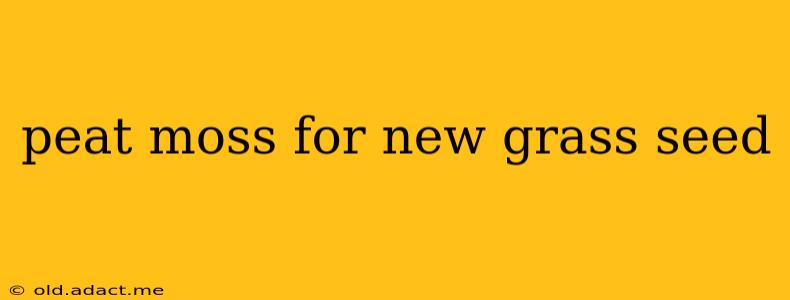Starting a new lawn from seed is an exciting project, but success hinges on choosing the right soil amendments. Peat moss is often touted as a beneficial addition, but is it truly necessary, and if so, how much should you use? Let's delve into the advantages and disadvantages of using peat moss when sowing new grass seed.
What is Peat Moss?
Peat moss, also known as sphagnum peat moss, is a partially decayed organic matter harvested from bogs. It's prized for its exceptional water-holding capacity, excellent aeration, and slightly acidic pH, making it a popular choice for gardeners and landscapers. However, its environmental impact is a growing concern, leading many to explore alternative soil amendments.
Benefits of Using Peat Moss for Grass Seed
-
Improved Water Retention: Peat moss acts like a sponge, retaining significant amounts of water. This is crucial for germinating grass seeds, which require consistent moisture to sprout and establish strong roots. In drier climates or during periods of drought, the added moisture retention provided by peat moss significantly improves seedling survival rates.
-
Enhanced Drainage: While peat moss holds water, it also improves drainage. This prevents waterlogging, a common problem that can suffocate grass seeds and young seedlings. The airy texture of peat moss allows for proper air circulation within the soil, fostering healthy root development.
-
Soil Structure Improvement: Peat moss helps create a loose, crumbly soil structure ideal for grass seed. This allows for better root penetration and nutrient uptake. It's especially beneficial for heavy clay soils, which can be compacted and poorly draining.
-
Slightly Acidic pH: Many grass varieties thrive in slightly acidic soil conditions. Peat moss contributes to maintaining a suitable pH level, further supporting healthy grass growth.
How Much Peat Moss Should I Use?
The amount of peat moss needed depends on your soil type and the existing organic matter content. Generally, a ratio of 1:1 or 1:2 (peat moss to soil) is recommended. For example, for a 10 square-foot area, you might mix 5-10 cubic feet of peat moss with your existing soil. It's best to conduct a soil test before amending, to assess the specific needs of your lawn.
What are the Alternatives to Peat Moss?
Environmental concerns have led many to explore alternatives to peat moss:
- Coco Coir: Derived from coconut husks, coco coir offers similar water retention and aeration properties to peat moss, but with a significantly lower environmental impact.
- Compost: Mature compost improves soil structure, drainage, and fertility. It's a readily available, eco-friendly option.
- Aged Bark: Provides excellent drainage and aeration, though it doesn't retain water as effectively as peat moss or coco coir.
Does Peat Moss Help with Weed Control?
Peat moss itself doesn't directly control weeds. However, by creating a healthier soil environment, it can indirectly contribute to improved grass growth, which can outcompete weeds. Pre-emergent herbicides, used according to label instructions, remain the most effective method for weed control.
Can I Use Peat Moss on Top of Existing Grass?
Peat moss is not typically recommended for topdressing existing lawns. It can hinder proper mowing and may not fully integrate into the existing turf. For existing lawns, topdressing with sand or compost is often a more suitable approach.
Is Peat Moss Expensive?
The cost of peat moss varies depending on location and supplier. It's generally considered a moderately priced soil amendment, though alternatives like coco coir can sometimes be more affordable.
Conclusion
Peat moss can be a valuable asset in establishing a new lawn from seed, offering benefits like improved water retention, drainage, and soil structure. However, it’s essential to consider its environmental impact and explore sustainable alternatives like coco coir or compost. Always consider your soil type, climate, and budget when deciding whether to use peat moss or a suitable alternative for your new grass seed. Remember to follow proper seeding techniques for optimal results.
